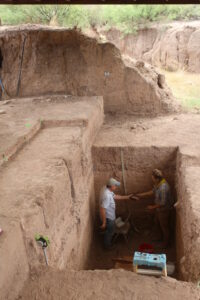
The Center for Big Bend Studies at Sul Ross State University is now in its fifth year of a collaboration with the Odyssey Archaeological Research Fund (OARF) at the University of Kansas, one of the largest endowments of its kind in the country.
The Odyssey program emphasizes the application of geologic methods and theories to systematically search for the early archaeological record of North America.
The partnership, which began in 2019 with a focus on education and finding evidence of the first people in the Big Bend, is sponsoring research at the San Esteban Rockshelter south of Marfa and the Genevieve Lykes Duncan (GLD) site in western Brewster County. Both sites have yielded previously unrecorded evidence of early human occupation of the Big Bend around 13,000 years ago.
“The relationship with Odyssey is allowing us to search for the earliest sites in the region,” said Dr. Bryon Schroeder, the director of CBBS. “With the exception of the GLD site, in the entire western half of Texas there are no known stratified buried Paleoindian sites, not because they aren’t there, but because they are deeply buried and we have never systematically looked for them. We do not know the role that the Texas desert had on the first peoples to enter America. That is astounding considering the adjacency of the region to some of the most famous early sites in North America, like Blackwater Draw.”

Dr. Rolfe D. Mandel, University of Kansas, and Erika Blecha, a staff archaeologist with the CBBS, collect soil samples from a deep excavation profile at the Genevieve Lykes Duncan site in Brewster County. The samples are used to tell how it was formed, its age, and about the past environment. CBBS photo
Schroeder said the work has local and national significance by providing a foundation for the investigation and interpretation of humans in the region, and how it’s related to larger issues of peopling the Americas.
Field crews have consisted of graduate and undergraduate students from the University of Kansas, Texas State University, The University of Texas El Paso and Sul Ross State University. One student recently received his Ph.D. based on his dissertation research at San Esteban.
The OARF, which is housed in the Kansas Geological Survey (KGS), was established in 2003 with a generous endowment from Joseph and Ruth Cramer.
Under the direction of Dr. Rolfe D. Mandel, KGS senior scientist and University Distinguished Professor in the Department of Anthropology, the goal of the program is to search for evidence of the earliest people to inhabit the Central Great Plains, Midwest and other areas of North America, and to gain a better understanding of how the late Pleistocene and early Holocene paleoenvironments affected them.
“The partnership between CBBS and Odyssey will continue indefinitely,” said Mandel. “This collaboration is an opportunity to bring together faculty, researchers, and students from Sul Ross State University and the University of Kansas to study archaeological sites that may harbor the earliest evidence of humans in the Big Bend region. In addition to training the next generation of archaeologists, that effort may help us gain a better understanding of the peopling of the Americas.”
This field and laboratory-based effort has focused on Paleoindian and Pre-Clovis archaeology and geoarchaeology in Kansas, Colorado, Nebraska, South Dakota, Missouri, Texas, and the Yukon Territory of Canada. In addition to funding thesis and dissertation research related to the program’s mission, Odyssey supports undergraduate and graduate students involved in the program’s summer field investigations.
To learn more about the Center for Big Bend Studies, visit https://cbbs.sulross.edu or email cbbs@sulross.edu.
